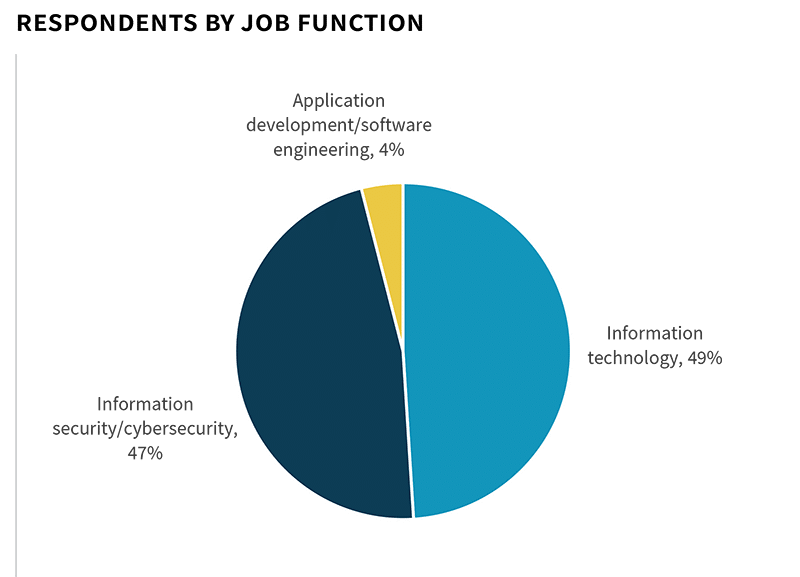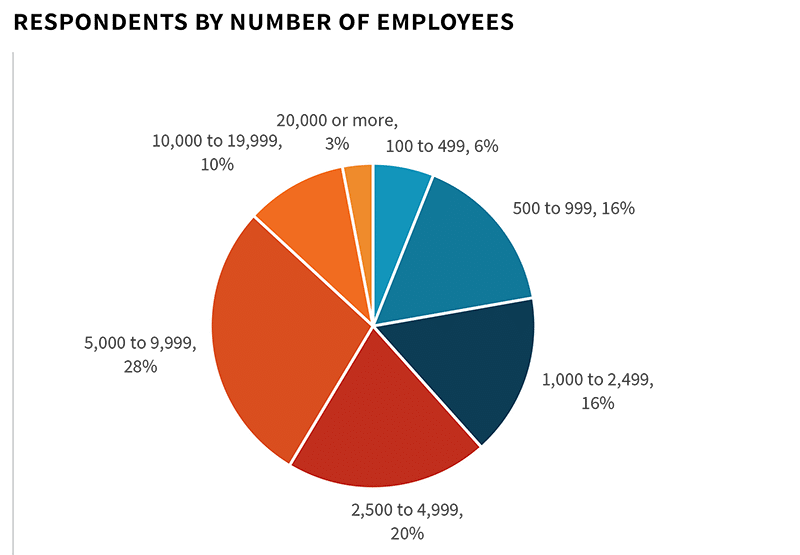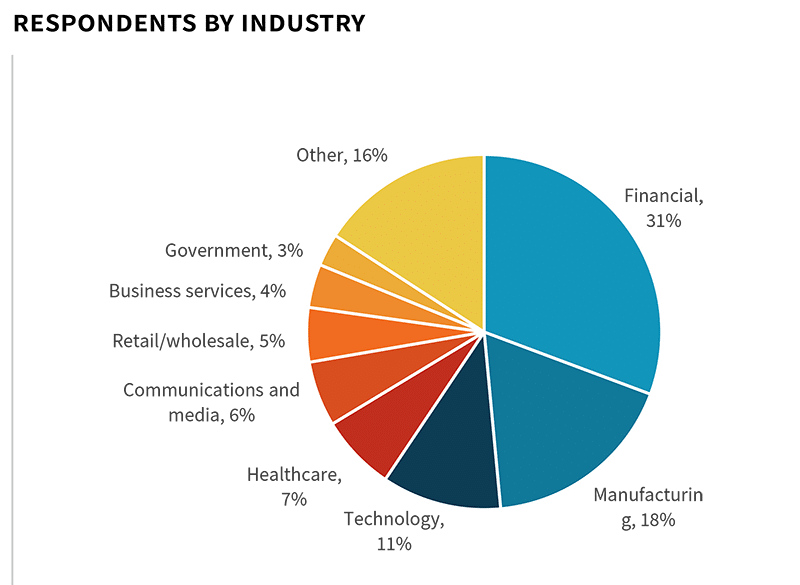In this ebook, John Grady, Senior Analyst at ESG, shares insights gathered from surveying 360+ IT, cybersecurity, and application development professionals involved with web application protection technology and processes in their respective organizations.
55% of organizations say securing their organization’s web applications has become more difficult over the last 2 years.
The top three challenges organizations face in protecting public-facing web applications include:
- An increase in threat landscape
- Increasing usage of cloud services
- Agile application development processes making it difficult to maintain proper security
Research Objectives
campaigns use bots to amplify denial of service and credential attacks that target web applications as well as the APIs they rely upon. Converged application protection platforms have emerged to address many of these issues, but organizations can struggle with prioritizing the capabilities they require, assessing the different types of tools available, and meeting the diverse needs of a broad set of stakeholders.
In order to gain insight into these trends, ESG surveyed 366 IT, cybersecurity, and application development professionals personally involved with web application protection technology and processes at North American organizations.
THIS STUDY SOUGHT TO:
KEY FINDINGS
Application Environments and Processes Continue to Evolve, Creating Security Complexity
The shift to cloud and adoption of agile DevOps are among the factors making application security more difficult.
Successful Application Attacks Can Impact Employees, Customers, and the Bottom Line
The broad range of attacks across applications and APIs makes prioritizing defense difficult.
Protecting Web Applications Is a Priority for Most,
Though Drivers Vary
Most say ensuring secure and available applications is a top 3 cybersecurity priority.
Tool Sprawl Has Become Problematic
New application architectures, locations, and processes all contribute to sprawl.
APIs Are of Particular Concern and Can Exacerbate Tool Sprawl
Visibility is a critical challenge to securing APIs.
There Is Significant Interest in Consolidation, with API
Security as a Focus
Many anticipate deploying WAAP in front of business-critical applications.
Application Environments and Processes Continue to Evolve, Creating Security Complexity
The Scale and Composition of Application Environments Will Change Significantly Over the Next 24 Months
More than ever, organizations rely on applications to engage with customers, connect with partners, and ultimately drive revenue for the business. While only 15% of organizations support more than 200 public-facing websites and applications today, nearly half (45%) expect to reach this milestone in the next 24 months. Yet as the scale of application deployments continues to accelerate, many organizations find themselves at an inflection point with their application environments. The reliance on the public cloud continues to grow, with the percentage of organizations running more than 30% of their applications on infrastructure-as-aservice (IaaS) expected to nearly double over the next 2 years. Even more telling, 71% expect at least half of their applications to run on microservices.
Public-facing websites and applications landscape.
Support more than 200 public-facing websites and applications
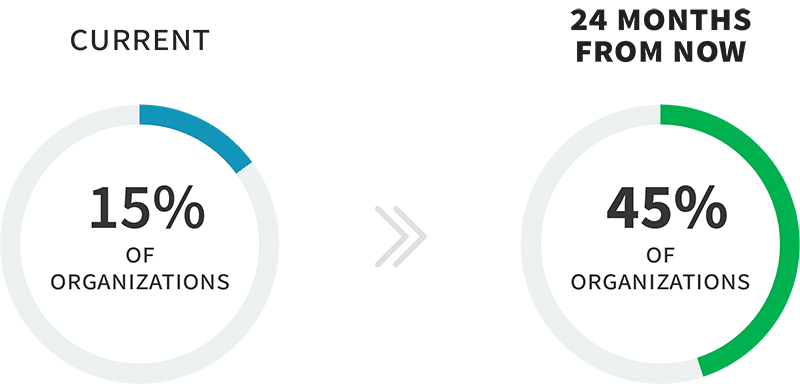
Over 30% of public-facing websites and applications run on public cloud infrastructure services (IaaS)
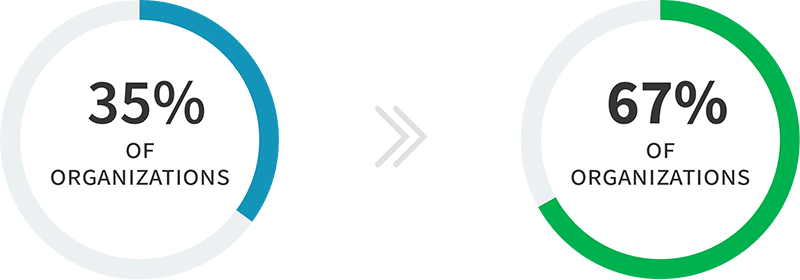
At least half of public-facing websites and applications run on microservices
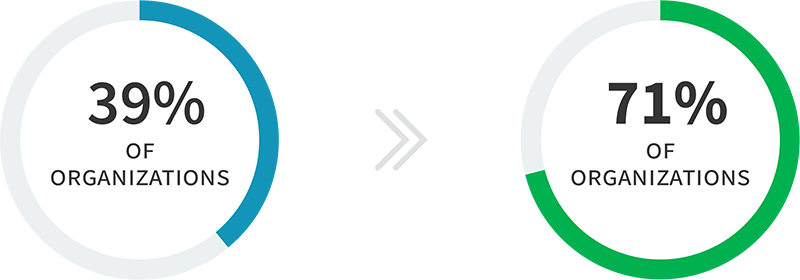
DevOps Has Become Pervasive, but Incorporating Security Remains a Work in Progress
To support the shift to IaaS, and more importantly cloud-native, microservices-based architectures, many organizations have turned to agile development methodologies. To better enable these practices, nearly three-quarters (74%) of organizations currently use DevOps to some extent. However, the incorporation of security remains a work in progress. Specifically, only 19% have extensively incorporated security into DevOps processes, with an additional 28% incorporating security in a limited fashion. This gap can result in security teams losing visibility across the environment and ultimately increase the potential for attackers to exploit critical applications.
“While 74% of organizations currently
use DevOps, only 47% have incorporated
security processes and controls.”
We have incorporated security into DevOps processes:



Threats Are a Commonly Cited Issue, but Only One Among Many
The transitions to cloud, microservices, and DevOps are critical to achieve better agility, scale, and efficiency—but they do create complexity. Overall, 55% of organizations say securing their organization’s web applications has become more difficult over the last 2 years. The most common reason was an increase in the threat landscape, cited by 46% of organizations. Yet the increasing use of cloud services (44%), incorporation of agile development processes (44%), and lack of clarity around ownership for security (42%) were close behind. Further, the security tools designed to protect corporate applications can often add complexity. Specifically, 36% say security tools are ineffective, and 32% indicated their organization has too many security tools.
55%
of organizations say securing their organization’s web
applications has become more difficult over the last 2 years.
Challenges faced protecting public-facing web applications.
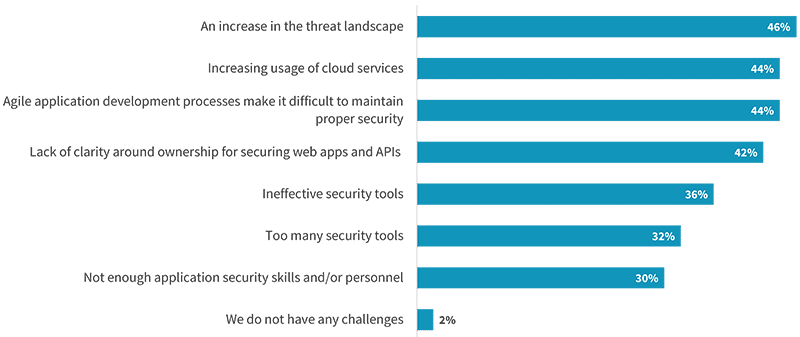
Successful Application Attacks Can Impact Employees, Customers, and the Bottom Line
Organizations Have Experienced a Variety of Attacks
Attackers have a wide range of avenues with which to target public-facing applications. Traditional application attacks using malware (34%), lesserknown vulnerabilities (26%), and OWASP Top-10 vulnerabilities (20%) were commonly reported. Denial of service attacks also remain a staple for attackers, with 27% reporting volumetric attacks, and 23% seeing Layer 7 attacks. However, credential-based attacks and attacks on APIs are becoming more commonplace. Credential stuffing or cracking attacks (30%), fake account creation (25%), and account takeover (21%) were often reported. On the API side, 28% of organizations reported injection attacks, while 23% reported attacks exploiting misconfigurations. Bots are often the common thread across many of these types of attacks, allowing bad actors to quickly scale denial of service, credential-based, and API attacks and overwhelm defenses.
Types of web application and API attacks experienced in the last 12 months.
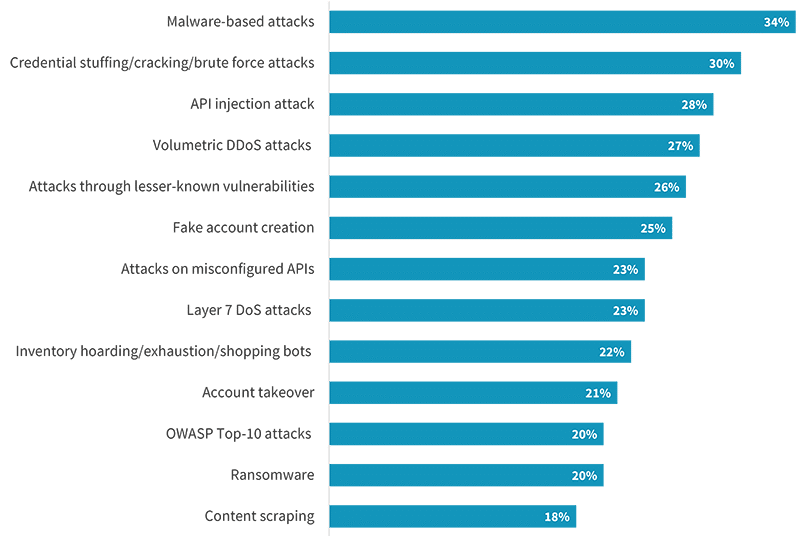
Application Attacks Can Impact Employees, Customers, and the Bottom Line
When successful attacks on public-facing applications and APIs do occur, the impacts can be significant, and many are related. Over 40% of organizations reported application downtime as the result of a web application or API attack. When applications are not available, customers can be impacted. Specifically, 34% reported negative customer experiences and 26% reported lost revenue as the result of application attacks. Further, when data breaches occur as the result of an application attack, brand standing and shareholder value can be affected (34%) and compliance issues can arise (26%). While not ideal or necessarily fair, these results help explain why 41% of respondents indicated that team members were impacted as the result of an application attack. This can include everything from requiring additional training, through reassignment, to termination.
Impacts organizations experienced from attacks on web applications and APIs.
41%
Team members were impacted
41%
Application downtime
38%
Web application protection products
34%
Negative impact to shareholder value
34%
Negative customer experiences
33%
Infrastructure cost overruns

26%
Compliance issues

26%
Loss of revenue
Protecting Web Applications Is a Priority for Most, Though Drivers Vary
Application Security Is a Cybersecurity Priority for Nearly All
Security teams have a variety of initiatives to plan for and support. Implementing zero trust, securing remote and hybrid work, supporting cloud migration, and modernizing threat detection and response are all important in their own right. However, the criticality of applications to the business and long list of negative impacts that can arise when those applications are not available or become compromised have resulted in most organizations elevating application security to one of their top cybersecurity priorities. In fact, one-third say that ensuring secure and available applications is their organization’s top cybersecurity priority, with an additional 54% placing it as a top three cybersecurity priority.
“Implementing zero trust, securing remote and hybrid work, supporting cloud migration, and modernizing threat detection and response are all important in their own right.”
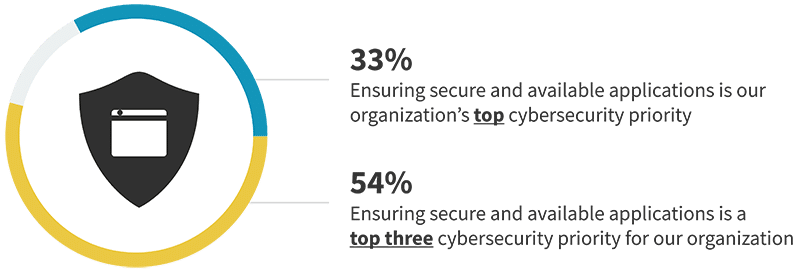
Critical Drivers for Spending on AppSec Vary
More than just paying lip service to prioritizing application security, organizations are allocating increased budget for protecting their web applications and APIs. Nine out of ten organizations anticipate increasing spending on web application and API protection technologies, services, and personnel over the next 12-18 months. While there is consensus on prioritization and increasing spending, there is less agreement on the top driver. Most organizations are focused on traditional security outcomes. The most common response selected was maintaining application uptime and user experience, cited by 18% of respondents. Protecting data, both consumer (16%) and corporate (14%), was also near the top of the list. Spending on application security to fulfill compliance and data governance requirements also continues to be common (16%). Yet some organizations do view application security spending as a business enabler. Controlling infrastructure cost overruns was selected by 12%, while 11% indicated that improving the bottom line was top of mind.
90%
anticipate increasing spending on web application and API protection technologies, services, and personnel over the next 12-18 months.
Most critical driver of spending on web application protection tools and services.
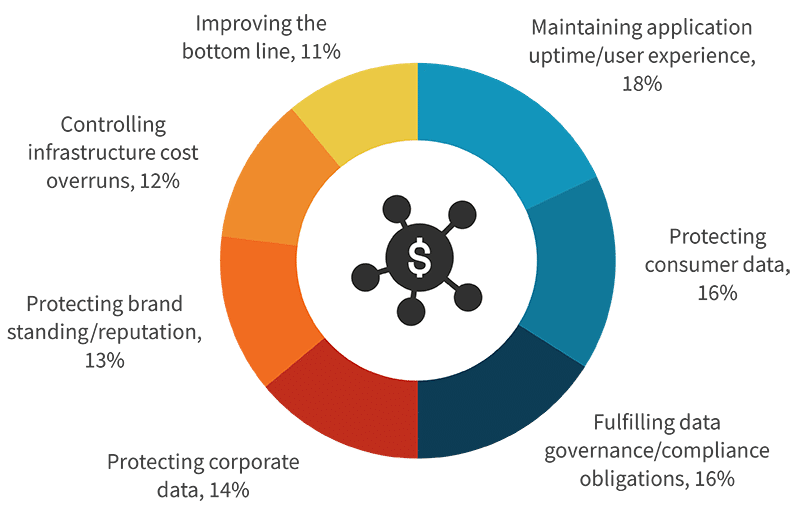
Tool Sprawl Has Become Problematic
A Variety of Tools and Capabilities Are Used to Protect Web Apps
While it is heartening to see organizations emphasizing application security and increasing spending, these dollars must be spent effectively. Currently, 72% of organizations use web application firewalls, with the vast majority of those using multiple WAFs from some combination of cloud service provider, CDNs, security vendors, and open source. Despite being introduced much more recently, API security tools have become critical for modern, microservices-based environments utilizing APIs. While foundational capabilities such as OWASP Top-10 vulnerability protections (27%) and virtual patching (31%) remain common, many organizations have begun to utilize advanced features such as behavior-based detections (39%), JavaScript challenges (34%), and device fingerprinting (32%).
Discrete tools used to protect web applications.
72%
Web application firewall (WAF)
52%
Distributed denial of service mitigation
64%
API security tools
45%
Bot management
Capabilities employed to protect web applications.
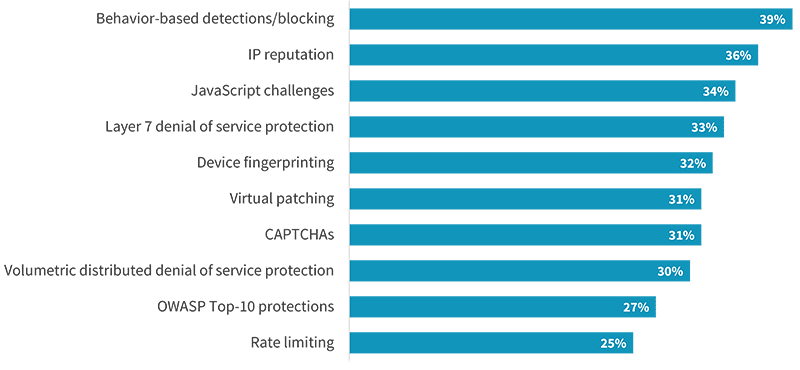
Tool Sprawl Can Occur Naturally or by Choice
There are a variety of reasons organizations end up with so many application security tools. As applications shift to the cloud and microservices are adopted, it can be natural to incrementally add tools for those specific use cases. Along the same lines, as DevOps has taken hold and security becomes more democratized, it only makes sense for developers to have a voice in tool selection. On the other side of the coin, 46% use multiple tools because they feel it provides better protection. Additionally, 38% added products when their original tools did not work as expected. Yet the challenges tools generally pose can become magnified if sprawl becomes too wide. Cost, alerts and false positives, and management were all mentioned as top challenges and are likely to become worse when multiple tools are deployed.
Web application security tool challenges.
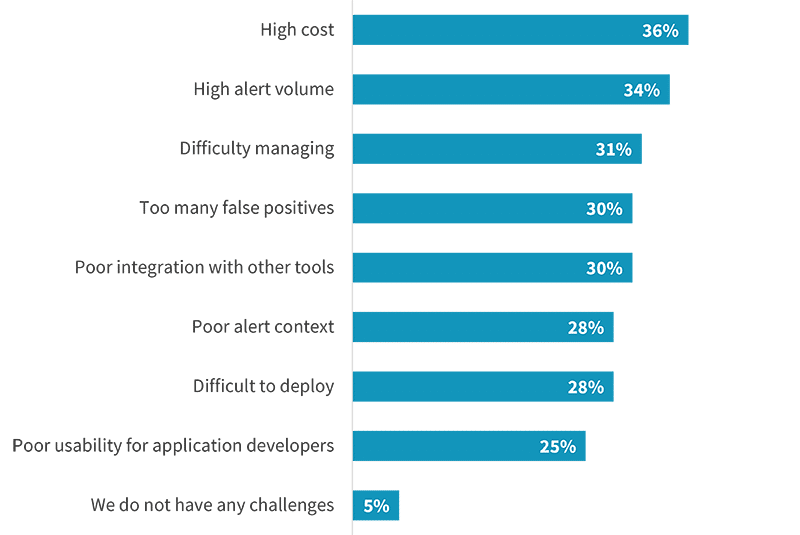
Reasons to use multiple web application protection tools.
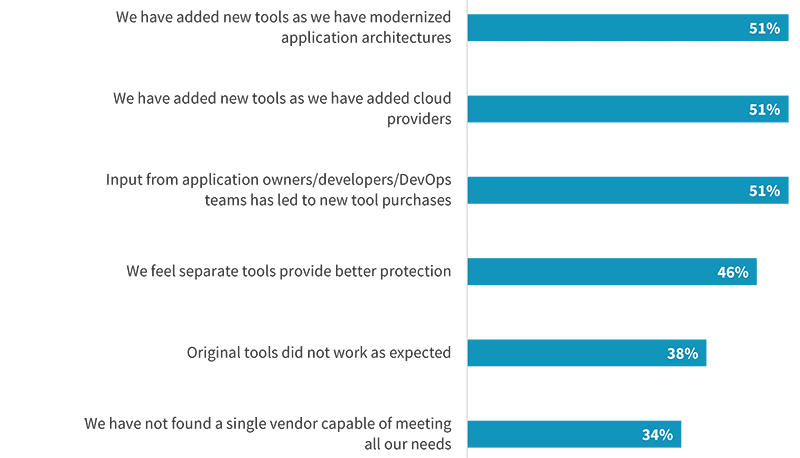
APIs Are of Particular Concern and Can Exacerbate Tool Sprawl
APIs Have Become Ubiquitous, Posing Many Challenges
API usage has grown as applications have become increasingly interconnected and the use of microservices-based architectures has expanded. In fact, only 4% of organizations currently say they have no applications that rely on APIs. However, the scale of applications dependent upon APIs is poised to grow significantly. Within two years, more than half (57%) of organizations believe that most or all of their applications will use APIs. Yet this shift can pose challenges when not properly addressed. Attackers have come to see APIs as attractive, often inadequately defended, targets and focus their attention accordingly. Further, as the scale of APIs in use across an organization increases, visibility can become a problem. More than onethird (37%) cited challenges with inventorying APIs, while 32% cited issues discovering and remediating misconfigurations. Finally, inadequate tooling comes into play again, both due to the use of too many tools (35%) and use of tools not purpose built for API security (31%).
API usage trends.
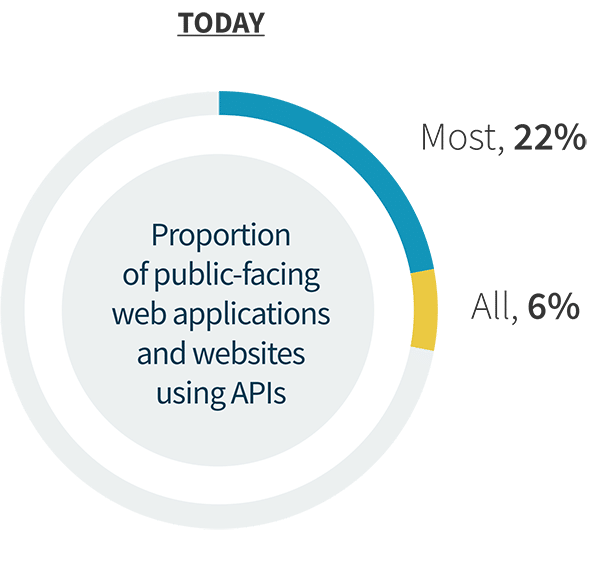
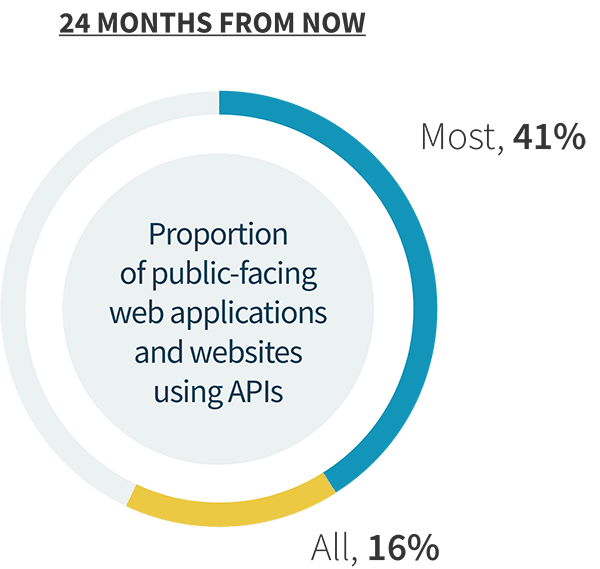
Biggest challenges protecting APIs.
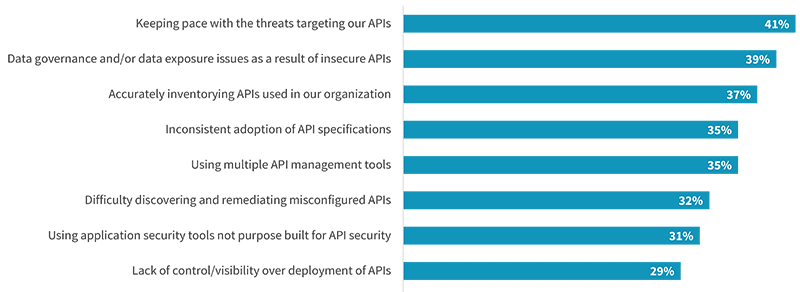
Key Gaps Remain Across the API Security Lifecycle
As noted, the range of tools used to discover, manage, configure, and protect APIs is long. When it comes specifically to protecting APIs, some organizations attempt to apply network security tool such as IPS or next-generation firewalls, or general application security tools such as WAF or bot mitigation. While these tools may be successful in preventing some basic types of attacks, they typically lack the visibility necessary to track the APIs in use across an entire environment, assess whether APIs are properly configured, and detect stealthy anomalous activity. While 44% of organizations indicated that API security tools were completely effective for protection, the fact that more than one-third found IPS, NGFW, bot mitigation, and WAF completely effective indicates that there remains confusion in the market.
Percentage of organizations that believe their API protection tools are completely effective:
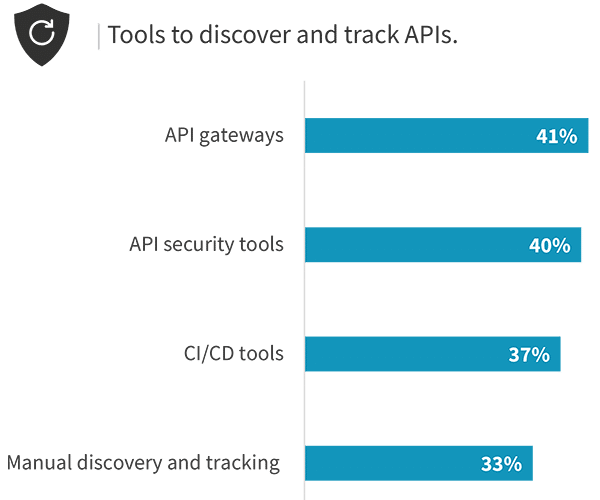
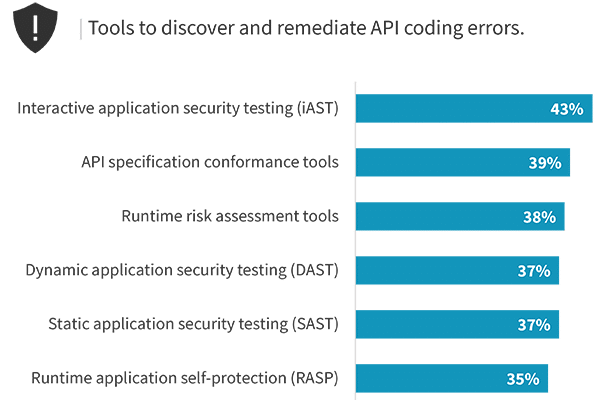
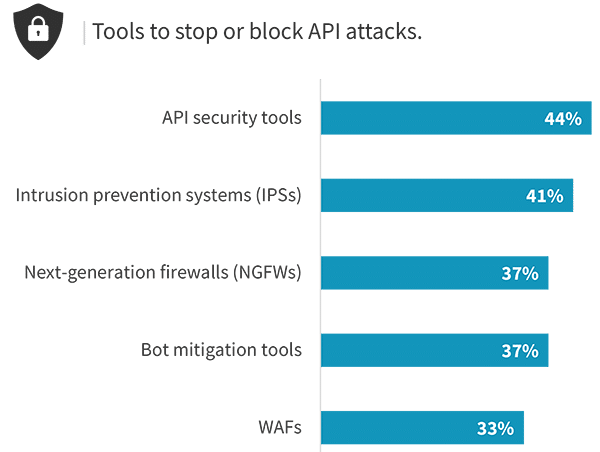
There Is Significant Interest in Consolidation, with API Security as a Focus
Strong Interest in Consolidation, but WAAP Deployment Will Be Phased
Due to the use of many different tools, cross-vector attacks, etc., interest in converged web application and API protection (WAAP) platforms has increased. Three-quarters of respondents indicated they are actively deploying a WAAP platform or planning to deploy one in the next 12-24 months. While 40% believe they will deploy WAAP across all their applications, the majority (54%) will continue to use a mix of tools depending on the application in question. Yet that does not mean WAAP is seen as a secondary control. In fact, more organizations plan to use WAAP for business-critical applications (37%) than secondary applications (32%). The most common usage, at least to start, is expected to be for applications reliant on APIs (42%) and resident in the cloud (40%).
Three-quarters
of respondents indicated they are actively deploying a WAAP platform or planning to deploy one in the next 12-24 months.
Extent of WAAP deployment.
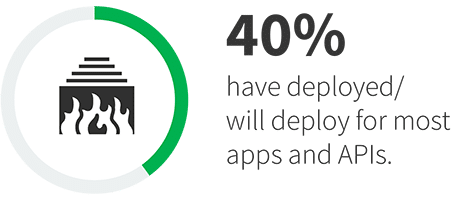
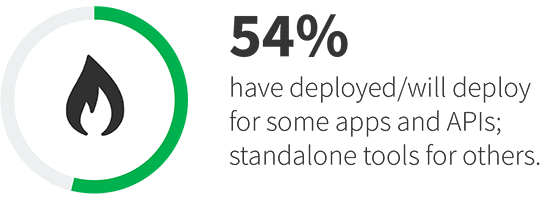
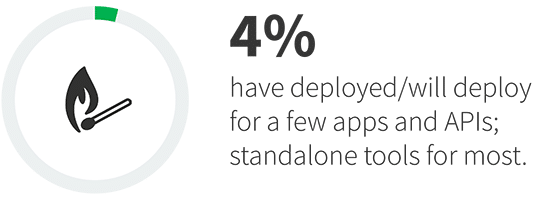
Types of applications and APIs expected to be protected by a WAAP platform.
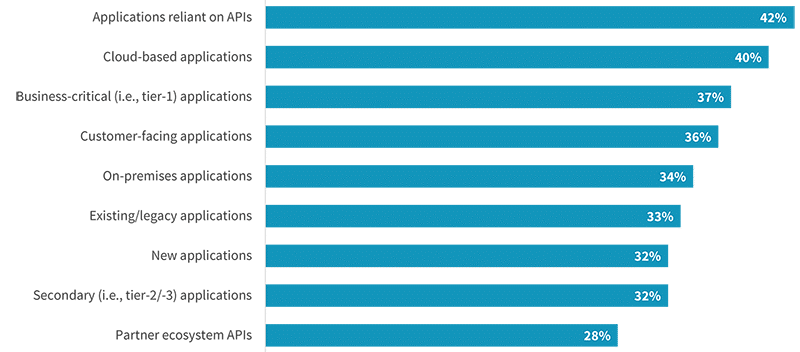
API Security and Deployment Flexibility Are Critical
This brings about the question: What characteristics should WAAP platforms have? As one might expect based on the previous findings, API security tops the list of most important tools in a WAAP platform, cited by 40% of respondents. While WAF, DDoS, and bot management were called out less frequently, these capabilities obviously remain a key component of WAAP. However, the explosion of APIs means discovery and protection capabilities must be purpose built rather than an afterthought. Interestingly, respondents were split on the ideal form factor for WAAP. While 35% prefer WAAP to be delivered as a cloud service, 32% desire a modulebased approach, and 26% remain drawn to a traditional appliance model. The need to protect legacy applications will continue for some time, ultimately requiring a flexible approach to WAAP.
Most important tools in a WAAP platform.
40%
API security
26%
WAF
17%
DDoS mitigation
17%
Bot management
WAAP platform deployment preference.
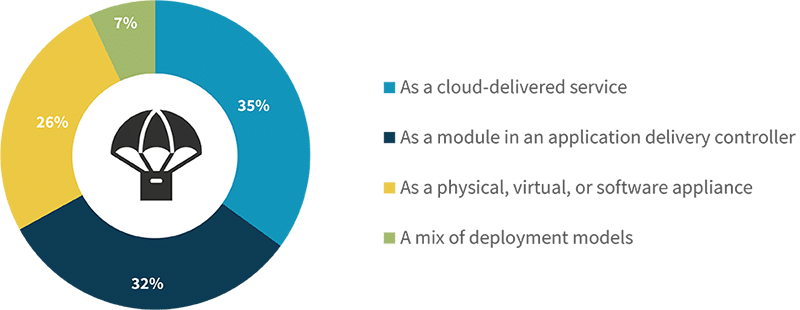
A Key Part of Fortra
Alert Logic is a proud to be part of Fortra’s comprehensive cybersecurity portfolio. Fortra simplifies today’s complex cybersecurity landscape by bringing complementary products together to solve problems in innovative ways. These integrated, scalable solutions address the fast-changing challenges you face in safeguarding your organization. With the help of powerful protection from Alert Logic and othes, Fortra is your relentless ally, here for you every step of the way in your cybersecurity journey.
Learn how you can protect your APIs with Fortra Managed WAF:

Research Methodology
To gather data for this report, ESG conducted a comprehensive online survey of IT, cybersecurity, and application development professionals from private- and public-sector organizations in North America between February 18, 2022 and February 28, 2022. To qualify for this survey, respondents were required to be IT, cybersecurity, and application development professionals familiar with their organization’s cybersecurity environment and web application protection tools, processes, and strategies. All respondents were provided an incentive to complete the survey in the form of cash awards and/or cash equivalents.
After filtering out unqualified respondents, removing duplicate responses, and screening the remaining completed responses (on a number of criteria) for data integrity, we were left with a final total sample of 366 cybersecurity and application development professionals.
